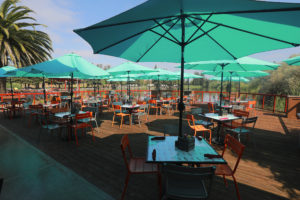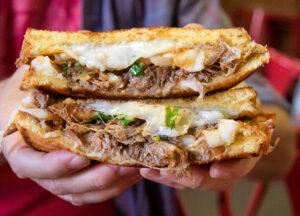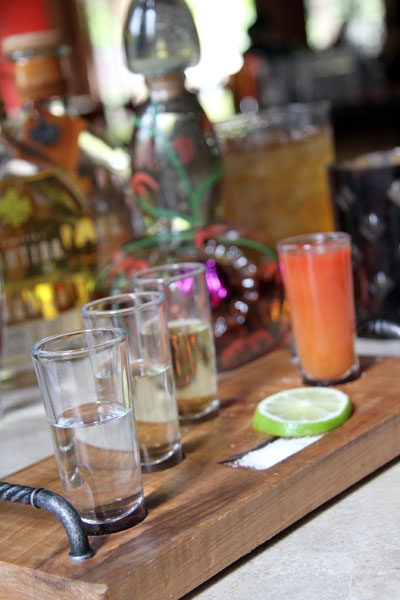
Just about everyone has a tequila story, and it usually doesn’t end well. I still have a dent in my forehead that was a direct result of face-planting on a wood deck after 14 shots. Synonymous with spring break, beaches, youthful indiscretions, and the Jersey Shore crew doing doing body shots, it’s gotten a bit of a bad rap.
But as Cinco de Mayo approaches, it’s worth taking a second look at this complex and oft-maligned nectar of the agave plant, along with its cousins Mezcal and Sotol. Not just for blending in margaritas anymore, well-crafted tequilas can be smooth enough for sipping and sampling straight up with some adult restraint.
Tequila 101
Tequila is a Mexican spirit that, like French champagne, can only be called tequila if it comes from a particular region — usually the state of Jalisco in central Mexico. Within that area are highlands and lowlands where the Blue Weber agave plant grows (the only type used for tequila), each imparting a unique flavor. Though the spiny shrub looks like a cactus, it is actually a yucca and takes up to 15 years to mature. The plants are harvested, then baked and finally distilled into tequila.
Do you know your blanco from your anejo? Like many spirits, tequila comes in a variety of styles, from unaged blanco (usually called labeled as “silver”) to reposado (rested), anejo (aged) and extra anejo (long-aged).
Experts describe the blanco as the most piquant of the group, the purest expression of the agave plant which goes into steel tanks and never sees oak. Most aged tequilas are put into oak barrels previously used for bourbon for one to five years. The barrels impart oaky, vanilla flavors as well as color. Anejo is typically aged between six months and a year, giving it a light caramel color and slightly smoother flavor. Aged tequilas can be much darker in color, and get a creamier, oaken quality from the amount of contact they have with the wood.
A few tequila brands to try:
Values: Oro Azul, Carralejo, Milagro
Mid Range: Partida, 7 Leguas
High End: DelLeon, Don Julio 1942
Mezcal
A smokier cousin to tequila, mezcal typically comes from the Oaxaca region of Mexico. And yes, its the spirit with the worm in it. In fact, it’s not actually a worm, but the larvae of a moth that likes to feed on agave, it’s sometimes put into a bottle to suggest that alcohol content is high enough to preserve the larvae. Historically it was thought to have magical healing properties.
Unlike tequila, for mezcal, the agave plant is roasted in the ground before distillation, giving the resulting spirit a smoky, earthy quality. Often made in small, artisanal batches (and rarely making it out of the Mexican market), mezcal is finally getting its due as higher quality varieties emerge on the American market.
Sotol
Almost unknown in the US, Sotol is a related spirit commonly from Chihuahua made from a wild agave plant known as Dasylirion or Desert Spoon. Cooked and distilled similarly to mezcal, the flavor tends to be smoother than tequila.
Where to get it locally
La Rosa Tequileria & Grill: The recently-opened cantina in downtown Santa Rosa has about 160 different tequilas. Co-owner Darren Chapple credits growing up in San Diego (just over the border from Tijuana) and his longtime employment in Mexican restaurants with his passion for tequila. “It’s just a growing trend, and is definitely my drinking choice,” he said. He and his staff hand-pick each of the tequilas carried at the restaurant, with a number of rarer, high-end tequilas along with a wide variety of more affordable tequilas. His take on blended margaritas? “We do them, but they’re better on the rocks,” And on salt and lime with a shot?. “It just covers up the flavor,” he said.
Try one of four specialty flights that range between $13 and $27, taking sippers through various regions and agings, along with a high-end tasting of “big dog” tequilas Clase Azula Plata, DeLeon Reposado and Don Julio 1942. The Smokey, a margarita made with both tequila and mezcal ($9) is a favorite as well.
Mezcal Tasting at Traverso’s: On May 5, Traverso’s will host a Mezcal tasting with Del Maguey owner Ron Cooper. One of the most popular brands of Mezcal, Del Maguey bottles small production spirits in remote villages. Each of the bottles bears the name of the village where it is produced. The event takes place from 7-9pm at the Hyatt Vineyard Creek Hotel, reservations are required. Info, (707) 542-2530 or info@traversos.com.
Benesin Mezcal: Santa Rosan Efrain Nolasco, a native of Oaxaca, imports small batch mezcal, which is certified organic. You can find it at liquor retailers in Sonoma County.
Tres Hombres Longbar and Grill: With more than 100 different tequilas, this Petaluma restaurant features a specialized club for serious tequila drinkers and several tequila dinners each year. Members of the club reach various levels by sampling different tequilas, and getting special incentives. 151 Petaluma Blvd. S., Suite 129, Petaluma, 773-4500.
Maya Restaurant: In the heart of downtown Sonoma, this Mexican restaurant offers a temple of tequila with more than 100 specialty tequilas, from the pricy Don Julio to more affordable Patron and Cabo Wabo. 101 E Napa St., Sonoma, 935-3500.
Have a favorite tequila or a local spot (uh, no, not your backyard) you like to sip? Tell us.










